Nippon Telegraph & Tel Bundle
Can NTT Continue to Dominate the Global Telecommunications Landscape?
Nippon Telegraph & Tel Company (NTT) has a rich history of innovation, evolving from a national provider to a global leader. Its strategic investments and global expansion have solidified its position in the telecommunications industry. Founded in Japan in 1952, NTT has consistently adapted to technological advancements and market demands.
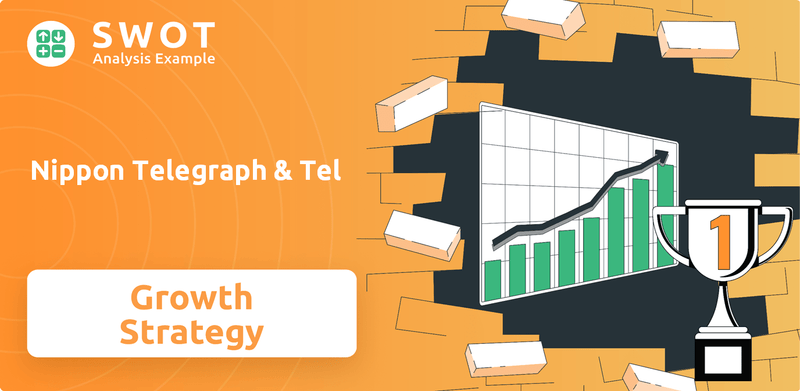
This article delves into the Nippon Telegraph & Tel SWOT Analysis, examining NTT's growth strategy and future prospects. We will explore NTT's business model, market analysis, and how it navigates the ever-changing telecommunications landscape. Furthermore, we'll analyze NTT's investment in 5G technology, its strategies for attracting talent, and its impact on the Japanese economy, providing insights into NTT's long-term vision and the challenges it faces.
How Is Nippon Telegraph & Tel Expanding Its Reach?
The expansion initiatives of Nippon Telegraph & Tel Company (NTT) are designed to bolster its global presence and diversify its revenue streams. This strategy is particularly focused on high-growth sectors such as cloud infrastructure, financial technology, and artificial intelligence. These efforts are crucial for NTT's future prospects, aligning with the evolving demands of the telecommunications and technology industries.
A key component of NTT's growth strategy involves significant investments in data centers. This includes substantial financial commitments to expand its data center business, ensuring it can meet the increasing demand for cloud services and digital infrastructure. These investments are strategically planned to capitalize on the growing needs of businesses worldwide.
NTT is also expanding its product and service offerings. This includes a focus on non-terrestrial networks (NTN) and Open Radio Access Networks (Open RAN). These initiatives are designed to enhance NTT's competitive advantage in the global market, especially in the rapidly evolving telecommunications landscape. For more insights, you can explore the Marketing Strategy of Nippon Telegraph & Tel.
NTT DATA Global Data Centers is investing over $10 billion through 2027 to expand its data center business. This includes strategic acquisitions and new builds to increase capacity and geographic reach. The expansion targets key markets to meet the growing demand for cloud services.
New data centers are planned in Milan, Italy, with a 128MW capacity, and Tochigi, Japan, with approximately 100MW capacity across two facilities. These expansions support NTT's goal of becoming a global leader in data center services. These moves enhance the firm's global presence.
NTT plans to build nine new data centers in India to capitalize on the booming IT and cloud markets. This aligns with India's Data Center Policy 2020, which aims to make the country a global data center hub. This is a strategic move to tap into the growing digital economy in India.
NTT DOCOMO is focusing on non-terrestrial networks (NTN) and Open Radio Access Networks (Open RAN). In April 2024, NTT DOCOMO and NEC established OREX SAI, INC. to provide OREX Packages for global Open RAN deployments. Southeast Asia is a key focus for volume deployments starting in late 2025 and hitting volume in 2026-2027.
NTT is expanding its 'NTT Startup Challenge' program in Southeast Asia to foster new business ventures. This program aims to support startups through partnerships, promoting innovation and growth. The program saw expanded participation from 8 to 13 companies in 2025, following approximately 700 applications in 2024.
- The expansion reflects NTT's commitment to innovation.
- The program helps NTT to identify and invest in promising startups.
- This initiative supports NTT's broader growth strategy.
- The focus is on creating new business opportunities.
Nippon Telegraph & Tel SWOT Analysis
- Complete SWOT Breakdown
- Fully Customizable
- Editable in Excel & Word
- Professional Formatting
- Investor-Ready Format
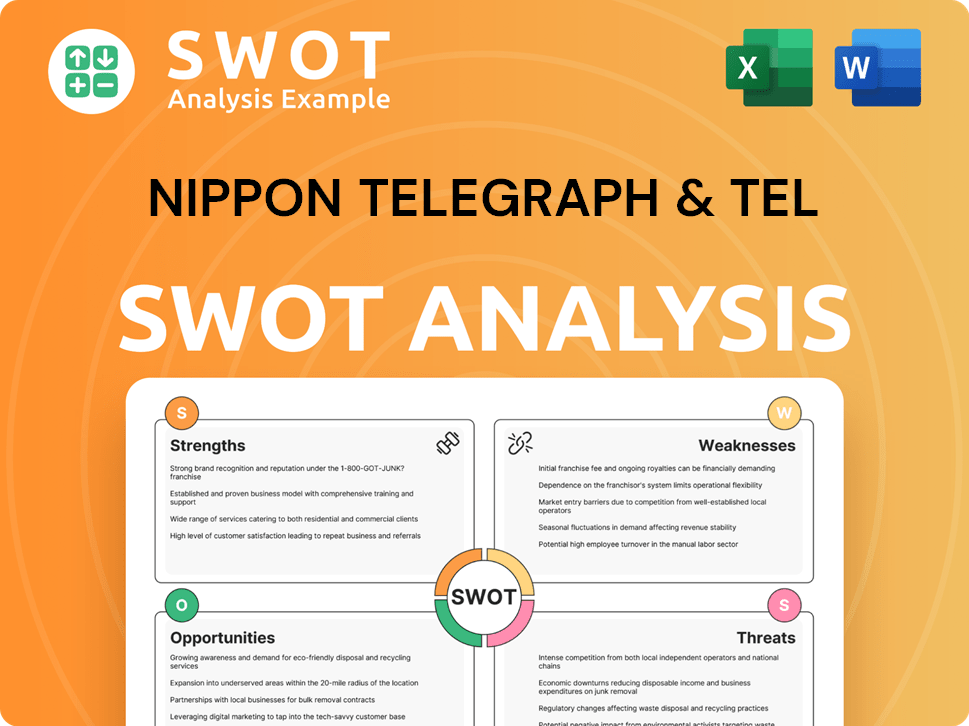
How Does Nippon Telegraph & Tel Invest in Innovation?
The innovation and technology strategy of Nippon Telegraph & Tel Company (NTT) is a core element of its NTT Growth Strategy, driving its future prospects in the telecommunications industry. NTT heavily invests in research and development, allocating a substantial annual budget to stay at the forefront of technological advancements. This commitment is crucial for maintaining a competitive edge in a rapidly evolving market and for achieving its long-term vision.
NTT's approach to technology and innovation is multifaceted, encompassing both internal development and strategic partnerships. This strategy allows NTT to explore diverse technological avenues and accelerate the commercialization of new solutions. By focusing on cutting-edge technologies, NTT aims to meet the evolving needs of its customers and maintain its leadership position in the global market.
NTT's commitment to innovation is evident in its significant investments in various technological domains, including advanced networking, artificial intelligence, and data center technologies. These initiatives are designed to enhance operational efficiency, improve service offerings, and create new revenue streams. The company's strategic focus on these areas is a key component of its NTT Business Model and its overall NTT Market Analysis.
The Innovative Optical and Wireless Network (IOWN) initiative is a cornerstone of NTT's innovation strategy. Launched in 2019, IOWN aims to revolutionize network infrastructure by transitioning to photonics-based technology. This transition promises significant improvements in energy efficiency, transmission capacity, and latency.
In 2024, NTT launched IOWN 2.0, expanding the initiative from networks to computing. This phase includes plans to introduce photonic technology for logic board-level connections by 2025. Commercialization of photonics-electronics convergence (PEC) devices is targeted for 2026.
Further advancements are planned with IOWN 3.0 and 4.0, scheduled for 2028 and 2032, respectively. These phases will focus on further miniaturization and integration of optical signaling within chips, continuing NTT's long-term vision for the future.
NTT is making significant strides in Artificial Intelligence (AI). Its AI platform 'tsuzumi' is undergoing a major upgrade in the current fiscal year. The upgrade will enhance its parameters to compete effectively with other large language models, positioning NTT at the forefront of AI innovation.
NTT introduced the Industry AI Cloud concept as a platform for utilizing AI for specialized tasks across various industries. This initiative aims to solve societal issues, such as optimizing agricultural trade and achieving zero traffic accidents, demonstrating NTT's commitment to sustainability initiatives and goals.
NTT DATA is actively contributing to the Open Gateway initiative, defining unified API specifications for network service monetization. It plans to participate in a Catalyst project in 2025 to utilize Open Gateway technology for automotive OEMs, showcasing its partnerships and collaborations.
NTT's technology strategy is centered around several key areas, including advanced networking, artificial intelligence, and data center technologies. These areas are critical for driving innovation and achieving its strategic objectives. The company's focus on these technologies is a key aspect of its adaptation to digital transformation and its competitive advantage in the global market.
- Advanced Networking: IOWN initiative, focusing on photonics-based technology to improve energy efficiency, capacity, and latency.
- Artificial Intelligence: Development of the 'tsuzumi' AI platform and the Industry AI Cloud concept for various applications.
- Data Center Technologies: Application of AI-driven cooling technologies and optimization of Power Usage Effectiveness (PUE) to improve efficiency and reduce environmental impact.
- Open Gateway Initiative: Defining unified API specifications for network service monetization.
Nippon Telegraph & Tel PESTLE Analysis
- Covers All 6 PESTLE Categories
- No Research Needed – Save Hours of Work
- Built by Experts, Trusted by Consultants
- Instant Download, Ready to Use
- 100% Editable, Fully Customizable
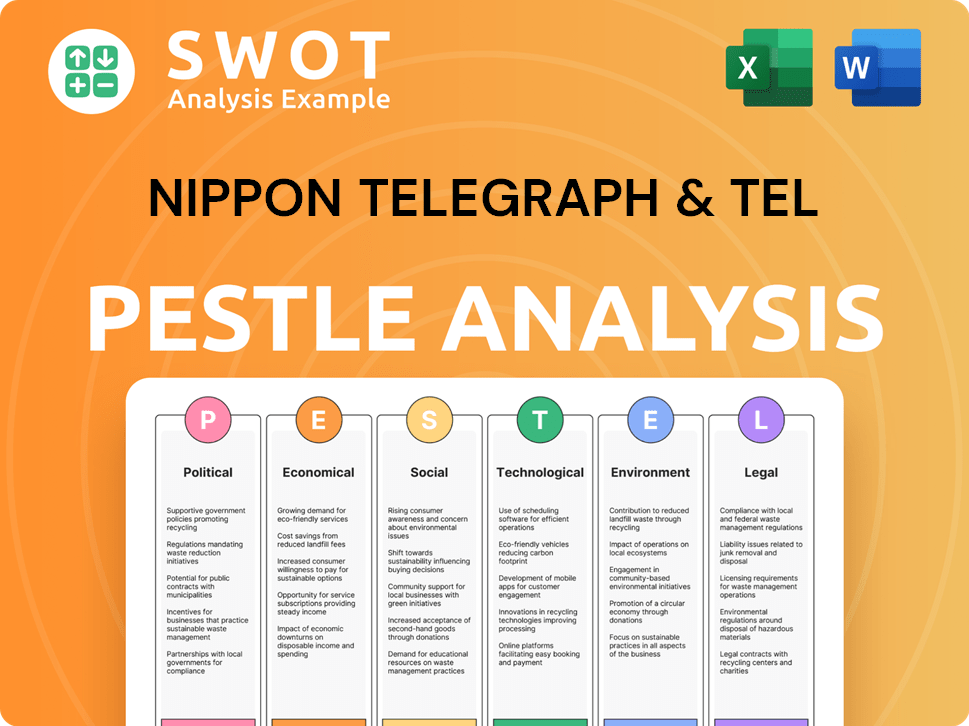
What Is Nippon Telegraph & Tel’s Growth Forecast?
The financial landscape of Nippon Telegraph & Tel Company (NTT) reflects a period of significant transformation and strategic investment. In fiscal year 2024, NTT's financial performance showcased both successes and challenges, setting the stage for future growth. The company's ability to navigate the evolving telecommunications market and expand into new sectors is crucial for its long-term success. Understanding the NTT Growth Strategy and NTT Future Prospects requires a deep dive into its financial results and strategic initiatives.
NTT's fiscal year 2024, ending March 31, 2025, was a pivotal year. The company's strategic investments and market positioning are key to understanding its financial outlook. The company is actively pursuing growth in new sectors while optimizing its existing operations. A closer look at the financial data reveals the dynamics of its current market position and future potential.
The company's focus on innovation and expansion, especially in the global market, is evident in its financial strategies. NTT’s commitment to its medium-term management strategy, 'New Value Creation & Sustainability 2027 Powered by IOWN,' highlights its vision. Examining the financial data provides insights into how NTT plans to achieve its strategic goals and maintain its competitive edge in the NTT Telecommunications sector.
NTT Group's net sales for fiscal year 2024 reached ¥10.05 trillion, a historic milestone. Operating revenues increased by 2.5% year-on-year to ¥13,704.7 billion. Despite these gains, EBITDA decreased by 5.2% to ¥3,239.3 billion, and operating profit fell by 14.2% to ¥1,649.6 billion.
NTT DATA Group's global expansion significantly contributed to the company's performance. NTT DATA Business Solutions reported record figures for fiscal year 2024/2025, with double-digit revenue growth of 14.7% to 1.85 billion euros. Cloud subscription sales increased by 49.5%.
NTT plans to invest approximately 8 trillion yen in new growth sectors over the next five years. The company announced a share buyback program of up to ¥200.0 billion from May 12, 2025, to March 31, 2026, to improve capital efficiency.
NTT views FY2024 as a 'bottom' year, with growth expected to accelerate in FY2025. The company aims to grow annual EBITDA to approximately 4 trillion yen by fiscal year 2027, a 20% increase over fiscal year 2022.
These financial results provide a glimpse into the NTT Market Analysis and the company's strategic direction. For a deeper understanding of NTT's business model and revenue streams, you can explore the Revenue Streams & Business Model of Nippon Telegraph & Tel.
Nippon Telegraph & Tel Business Model Canvas
- Complete 9-Block Business Model Canvas
- Effortlessly Communicate Your Business Strategy
- Investor-Ready BMC Format
- 100% Editable and Customizable
- Clear and Structured Layout
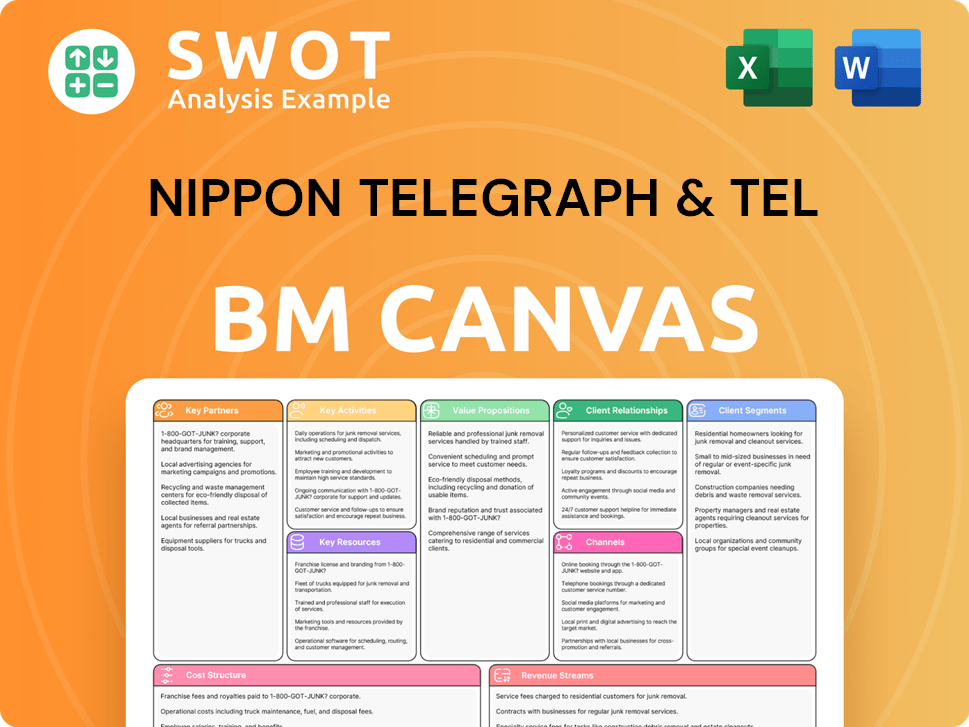
What Risks Could Slow Nippon Telegraph & Tel’s Growth?
The growth strategy of Nippon Telegraph & Tel Company (NTT) faces several potential risks and obstacles. These challenges span market competition, regulatory changes, cybersecurity threats, and the rapid pace of technological disruption. Understanding these risks is crucial for assessing NTT's future prospects and its ability to execute its expansion plans effectively.
Market dynamics in the telecommunications industry present ongoing hurdles for NTT. Regulatory shifts, especially concerning data privacy, cybersecurity, and the rise of AI, could significantly impact NTT's operations. Furthermore, the company must navigate supply chain vulnerabilities and geopolitical risks to maintain its competitive edge.
Technological advancements pose a constant need for adaptation and investment. NTT's commitment to innovation must keep pace with the demand for high-performance workloads driven by AI and cloud computing. Moreover, addressing the 'AI responsibility gap' is critical for maintaining public trust and ensuring successful AI adoption.
The telecommunications market is highly competitive. NTT must continually innovate and adapt to maintain its market share against both established and emerging competitors. This requires significant investment in infrastructure and services to stay ahead.
Changes in regulations related to data privacy, cybersecurity, and emerging technologies such as AI can impact NTT's operations. Compliance with these evolving standards requires significant resources and strategic adjustments. These changes are a constant factor in the Competitors Landscape of Nippon Telegraph & Tel.
Cybersecurity threats are a major concern, with AI-driven cybercrime, including ransomware and phishing attacks, expected to increase. NTT must invest in robust security measures to protect its infrastructure and customer data. Supply chain attacks are another key cybersecurity trend.
Rapid technological change necessitates continuous adaptation and investment. The demand for high-performance workloads driven by AI and cloud computing requires constant infrastructure upgrades. NTT must stay at the forefront of these changes.
Businesses are rapidly adopting AI, but leadership, governance, and workforce readiness are not keeping pace. This "AI responsibility gap" raises concerns about investment, security, and public trust. Over 80% of leaders surveyed indicated that unclear government regulations hinder AI investment and implementation.
AI ambitions may conflict with corporate sustainability goals. 75% of leaders believe this, forcing organizations to rethink energy-intensive AI solutions. This requires NTT to balance technological advancement with environmental responsibility.
NTT emphasizes proactive security measures, enhancing detection capabilities, and reinforcing supply chain security to mitigate risks. The company also focuses on staying attuned to geopolitical risks that could impact its operations and expansion plans. Furthermore, NTT is committed to embedding responsibility into AI through design, governance, workforce readiness, and ethical frameworks.
Continuous investment in infrastructure upgrades is crucial to meet the demands of AI and cloud computing. NTT must adapt to the rapid pace of technological change to maintain its competitive advantage. Addressing the "AI responsibility gap" requires significant investment in workforce training and ethical frameworks.
Nippon Telegraph & Tel Porter's Five Forces Analysis
- Covers All 5 Competitive Forces in Detail
- Structured for Consultants, Students, and Founders
- 100% Editable in Microsoft Word & Excel
- Instant Digital Download – Use Immediately
- Compatible with Mac & PC – Fully Unlocked
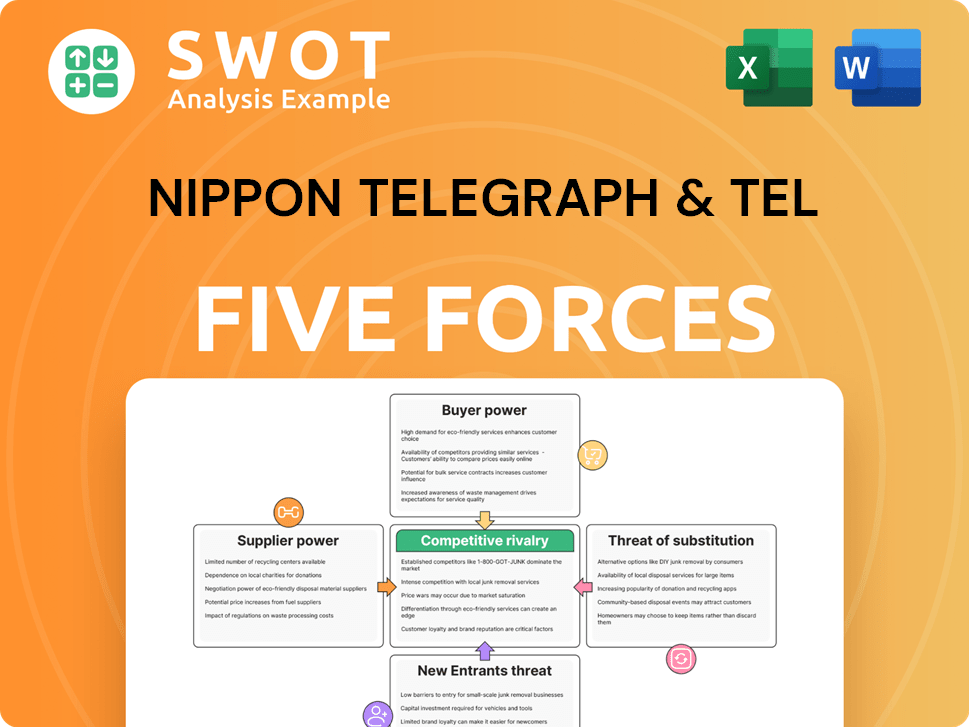
Related Blogs
- What are Mission Vision & Core Values of Nippon Telegraph & Tel Company?
- What is Competitive Landscape of Nippon Telegraph & Tel Company?
- How Does Nippon Telegraph & Tel Company Work?
- What is Sales and Marketing Strategy of Nippon Telegraph & Tel Company?
- What is Brief History of Nippon Telegraph & Tel Company?
- Who Owns Nippon Telegraph & Tel Company?
- What is Customer Demographics and Target Market of Nippon Telegraph & Tel Company?
Disclaimer
All information, articles, and product details provided on this website are for general informational and educational purposes only. We do not claim any ownership over, nor do we intend to infringe upon, any trademarks, copyrights, logos, brand names, or other intellectual property mentioned or depicted on this site. Such intellectual property remains the property of its respective owners, and any references here are made solely for identification or informational purposes, without implying any affiliation, endorsement, or partnership.
We make no representations or warranties, express or implied, regarding the accuracy, completeness, or suitability of any content or products presented. Nothing on this website should be construed as legal, tax, investment, financial, medical, or other professional advice. In addition, no part of this site—including articles or product references—constitutes a solicitation, recommendation, endorsement, advertisement, or offer to buy or sell any securities, franchises, or other financial instruments, particularly in jurisdictions where such activity would be unlawful.
All content is of a general nature and may not address the specific circumstances of any individual or entity. It is not a substitute for professional advice or services. Any actions you take based on the information provided here are strictly at your own risk. You accept full responsibility for any decisions or outcomes arising from your use of this website and agree to release us from any liability in connection with your use of, or reliance upon, the content or products found herein.